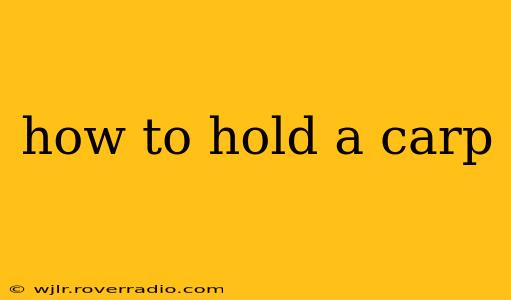Catching a carp is a rewarding experience for any angler, but knowing how to handle these powerful fish correctly is crucial for their well-being and your safety. Improper handling can injure the fish, increasing its susceptibility to disease and reducing its chances of survival. This guide will walk you through the best practices for holding a carp, ensuring both its safety and yours.
Why Proper Handling is Crucial
Carp are strong and surprisingly resilient fish, but they're also delicate. Their scales are easily damaged, and improper handling can lead to:
- Scale loss: This exposes the fish to infections and parasites.
- Mucus damage: The protective mucus layer on their skin is vital for their health. Rough handling can strip this away, leaving them vulnerable.
- Internal injuries: Incorrect gripping can cause internal damage to their organs.
- Stress: Excessive handling stresses the fish, weakening their immune system.
How to Hold a Carp: Step-by-Step
Here's a detailed guide on how to safely and correctly hold a carp:
-
Wet your hands: Before touching the carp, wet your hands thoroughly. This helps prevent the removal of their protective mucus layer.
-
Support the fish: Use both hands to support the carp's body. One hand should be gently cradling the body beneath the pectoral fins, while the other supports its belly and lower caudal fin (tail) area. Avoid squeezing.
-
Maintain its body position: Keep the carp's body as horizontal as possible to avoid stressing its spine and internal organs.
-
Minimize handling time: Handle the carp for as short a time as possible. Only handle it long enough to unhook it, take a quick photo (if you choose), and assess its condition before carefully returning it to the water.
-
Avoid lifting by the gills or lips: Never lift a carp by its gills or lips. This is extremely painful and can cause serious injury.
-
Avoid holding it by the tail: While you might support the tail area slightly, never lift a carp only by its tail. This puts unnecessary stress on its spine and can cause significant damage.
What to Do After Holding a Carp
After you've handled the carp, gently return it to the water. Make sure you support its body as you do so, allowing it to recover naturally in the water.
How long should I hold a carp for?
The ideal holding time is minimal. Unhook it quickly, take a photo if necessary, and immediately return it to the water. Prolonged handling stresses the fish unnecessarily.
What's the best way to remove a hook from a carp?
Use long-nosed pliers or forceps to gently remove the hook. If the hook is deeply embedded, it's best to cut the line close to the hook and allow the fish to expel it naturally.
Should I weigh a carp?
Weighing a carp is generally discouraged unless it's absolutely necessary for a competition or research purposes. Weighing can add significant stress and risk of injury. If you must weigh it, use a weigh sling designed for fish.
What are the signs of a stressed carp?
Signs of a stressed carp include rapid gill movement, lethargy, and difficulty swimming. If you notice these signs, return the carp to the water immediately and give it ample time to recover.
By following these guidelines, you can ensure the safe and responsible handling of carp, contributing to the preservation of these magnificent fish and their populations. Remember, catch and release fishing should prioritize the well-being of the fish above all else.
